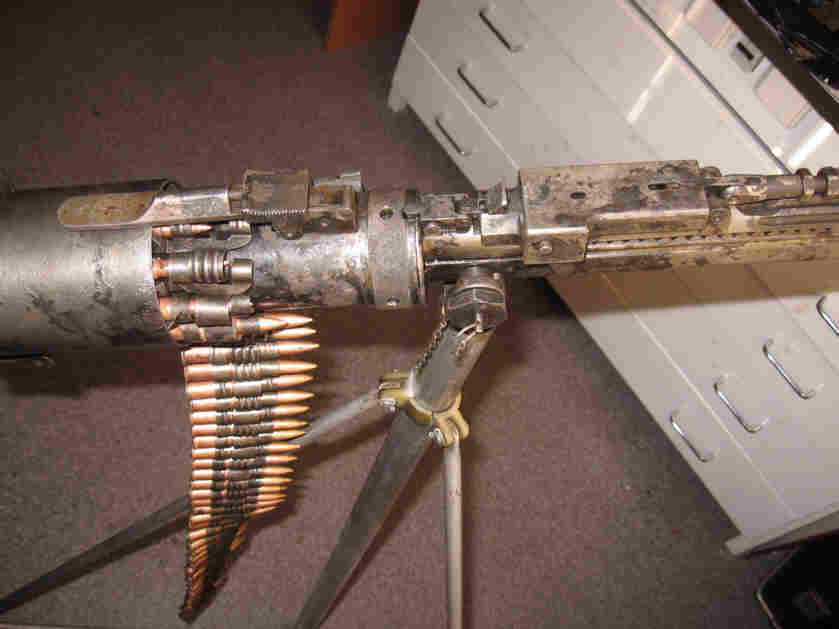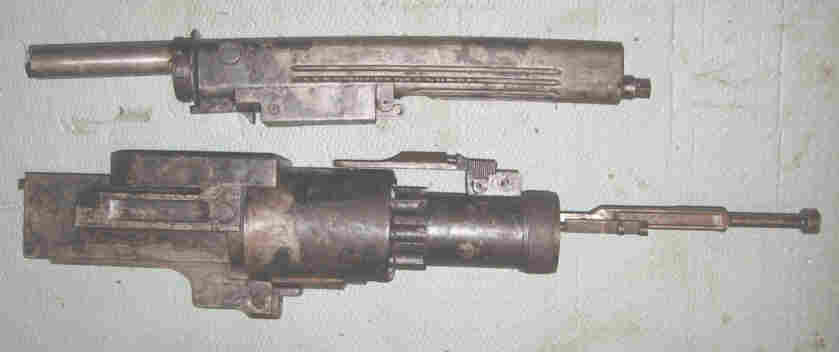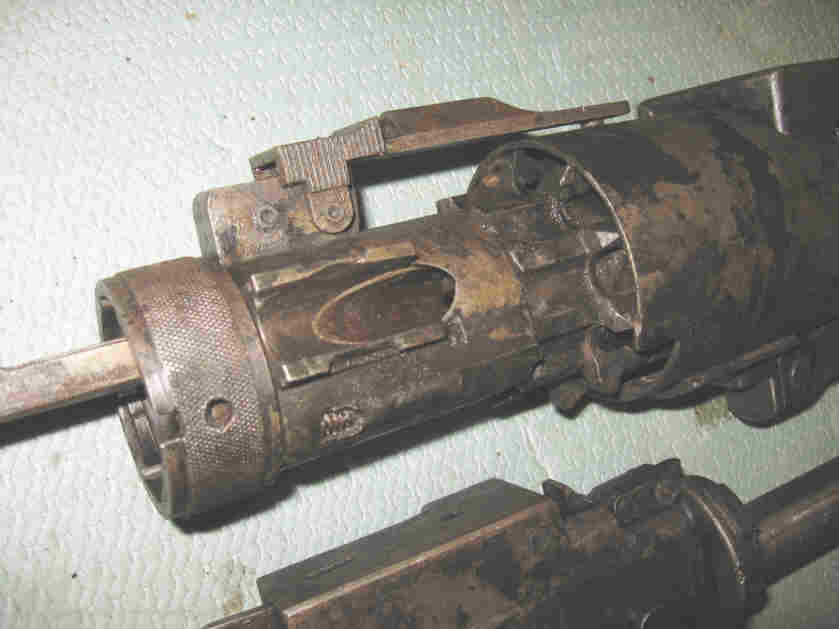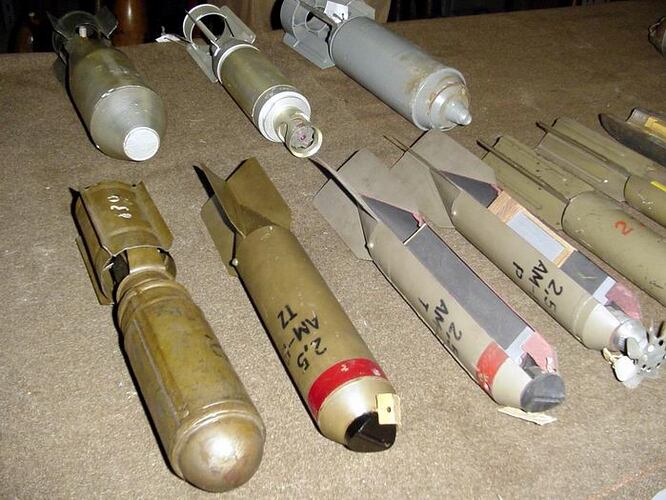Ok. thanks :), the russians seems to call this bombs “acumulative effect weapon”
Yes, kind of. “Cumulative charge” where the armor whould be penetrated by “cumulative stream” caused by the shape of the explosive warhead.
A “Shaped charge” in English.
Hello here is a PTAB container. May be Egorka couldt help with a closer translation  The aircraft is an YAK-9.
The aircraft is an YAK-9.
Protivo Tankowye Avia Bomby = PTAB
Anti Tank Aerial Bomb

Photo #1: The typical situation with PTAB 2,5-1,5 bombs “hanging” while used in the configuration with experimental container on YAK-9 (photo from the archive of the Yakovlev construction beuro).
Photo#2: Shown the insertion process of the PTAB 2,5-1,5 antitank bombs into the container for small caliber bombs on Yak-9 (photo from the archive of the Yakovlev construction beuro).
Thanks 
Here are some nice break down pics of an dig out Shkas.
A friend in the north of Moscow dig out a Yak fighter. The guns are in
nice condition but the barrels are bend a little bit.
Nice detail studies. It is interesting that the belt run in a “cage” and the cartridges where pulled to the rear out of the belt.
It is a fixed gun so no grip or shoulder stock.
Here is a supplement … a picture Ive forgotten and a translation of the polish PTAB index . :mrgreen::mrgreen:
- Shaped charge liner.
- HE charge.
- Bomb body.
- Fragmentation jacket
- Booster.
- Primer.
- Inertial weight with firing pin.
- Inertial weight spring.
- AD-A fuze.
- Arming propeller.
- Stabilizer.
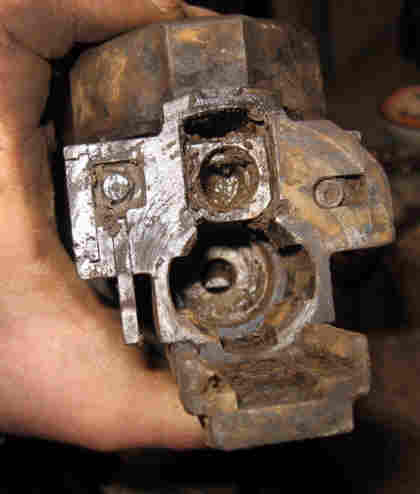
Here are some nice break down pics of an dig out Shkas.
Nice find !, what a good luck for them that could find things like this with a shovel. 
ShVak heavy MG 12,7mm.
The early years of 1930s were characterized by the great qualitative jump in the development of the military aviation. It substantially increased the speed, weight and payload, thus also the resistance of combat aircrafts.
In connection with this the 9 of February of 1931 the Soviet High Command decided that was needed a new machine gun caliber 12,7mm to combat against the recent generation of fighters and bombers. Responding to this requirement it is born the ShVak, Shpitalny Vladimirov Aviatsionny Krupnokalibr, Aeronautic Weapon of Shpitalny and Vladimirov heavy caliber.

The prototype of the machine gun was finished in Tula the 28th May 1932.
The principle of the operation by means of gas energy with a piston operating the opening of the sliding bolt. It was basically an enlarged Shkas.
Length of the gun was 1246 millimeters , it had 8 grooves right twist, overall lenght 1726 millimeters.
Rate of fire a 820-850 rpm. It was proposed to be adopted in three versions, wing, sinchro and turret emplacements.
In 1932 - 1933 the machine gun underwent tests and in 1934 of I declare apt to enter in good condition. Nevertheless the enthusiasm of the BBS with the new weapon was shot lived.
The ShVak of 12,7mm showed a series of disadvantages such as:
-
Excessively high Number of mechanical failures, not only that but also sometimes to clear a jam in the weapon has to be completely disarmed in its feeding mechanism and/or including the conductive drum of the cartridge belt… wich obviously a task impossible to perform in actual combat.
-
Excessive number of mechanized pieces, the number of component was greater due to the modifications realised by Vladimirov to the Shkas to accept the larger caliber case.
-
Expensive Construction, for the same reasons above.
-
Non standard Ammunition, the worsest from the Soviet point of view.
The Shvak did not use the conventional ammunition of 12.7 but one specially designed 12,7mm x 108R, the R obvious indicates the presence of a rim, this was necessary since the system of Shpitalny did not adapt to the cartridges with extraction groove. (rimless case)
All these reasons caused that its fabrication was very limited. In the year of 1934 only 12 issues were constructed and 86 the following year, finally it was decided to give up with this weapon in favour of a heavier 20mm variant.
The standardized weapon of aviation in caliber the 12.7 shall be the Universaly Berezin that used the cartridge DShk 1934. The production of of Shvak 12.7 mm finalize definitively in 1936.
Actually the effective age of 12.7 mm mashin guns have soon finished.
It has been excenged by the new sort of fighter wearpon - aviation 20-mm gun ShVAK.
The previously designed 12.7 ShVAK mashing gun has a such great store of reliablility , that it lets to increase the caliber up to 20 mm without serious modernization of mechanisms.
The main replacement was the new barrel.
http://en.wikipedia.org/wiki/ShVAK_cannon

The ShVAK 20 mm autocannon is a large-caliber version of the 12.7 mm ShKAS machine gun. The machine gun entered production in 1934 but proved unreliable, difficult to manufacture, and prone to jamming which often required partial or complete disassembly of the weapon. Its production was stopped in 1936. The autocannon version differed only in larger caliber of the barrel. It is a gas-operated belt-fed weapon with either cable or pneumatic charging in remote applications. ShVAK ammunition consisted of a mix of fragmentation-incendiary and armor piercing-incendiary rounds. The damaging effect of this ammunition was considered weak for the caliber. As the result, towards the end of Great Patriotic War ShVAK was supplanted by the Berezin B-20, Volkov-Yartsev VYa-23, and Nudelman-Suranov NS-37 autocannons.
It was the first soviet autocannon that was widely installed almost at the all kind of soviet fighters.Jak,La,Mig.it was most famouse and mass prodused soviet autocannon - more then 100 000 of gun have been produce sine the 1942 till the 1946
Although the damage effect was relatively weak for 20-mm shel, the the latest ShVAK modification was enough good to use for soviet pilots.

The wing of Bf-109 hit by burst of the SvVAK gun.
The time of ShVAk has ended when the Germans started to produse the newest kind of fighters FW-190D5 and Bf-109K in the 1944.
The SOviet pilots needed the new kind of autocannon.
The one of such new gun was the Beresin B-20, excellent gun that has been admitted at production in mid 1944.

[ul]
[li]Ammunition: 20 x 99 mm (0.8 x 3.9 in)
[/li][li]Empty weight: 25 kg (55 lb)
[/li][li]Muzzle velocity: 750-770 m/s (2,460-2,525 ft/s)
[/li][li]Rate of fire: 800 rounds/min
[/li][li]Mass of one-second burst: 0.95 kg (2.1 lb)
[/li][/ul]
The B-20 was created by M.E. Berezin in 1944 by chambering his Berezin UB 12.7 mm machine gun for the 20 mm rounds used by the ShVAK cannon. No other changes were made to the weapon which was pneumatically or mechanically charged and was available in both synchronized and unsynchronized versions. In 1946, an electrically-fired version was created for the turrets of the Tupolev Tu-4 bomber until the Nudelman-Rikhter NR-23 cannon became available. The B-20 was a welcome replacement for the ShVAK because is was significantly lighter (25 kg (55 lb) vs ShVAK’s 40 kg (80 lb)) without sacrificing rate of fire or muzzle velocity.
The B-20 was much more effetive , beeing installed to the La-7, in fight against the last germans fighters.
The modification of La-7 with 3 B-20 is the my favorite soviet fighter in my combat simulator IL-2. This is astually the uber-fighter on the low/medium altitude
P.S. PZ, can you change the title of this thread - i don’t know the country URSS:)
P.S. PZ, can you change the title of this thread - i don’t know the country URSS
Well is the Union Republicas Socialistas Sovieticas, I made a mistake and put the title with initials of the spanish designation for the Soviet union, sorry I am no more moderator ( :rolleyes:…:roll: ) so other should do it.
Actually the effective age of 12.7 mm mashin guns have soon finished.
It has been excenged by the new sort of fighter wearpon - aviation 20-mm gun ShVAK.
Yea, I know, but the VV-S gave up 12,7 mm variant in 1936, some were put in the Polikarpov I-16.
Ammunition for ShVak 12,7 mm.

Two pictures of the 12,7x108 rimmed cartrigde, the armor piercing tracer) BZT projectile had a muzzle speed of 825 m/s, it could pierce 13mm homogeneous steel plate at 350 meters.

The endurance of tracer element was 3 seconds, enough for 1500-1600
meters.
12,7x108 mm for Universaly Berezina:
The design of this ammunition was strongly was influenced by the german antitank Mauser cartrigde 13x92sr and the USA .50BMG (12,7x99mm) nevertheless it was designed to be more powerful that its predecessors.
Incidentally this ammunition was used also in some experimental antitank rifles, but in 1940 that task was taken by the bigger and meaner 14,5x114mm cartrigde.
B-30: Armor-piercing steel core, Projectile weight 51.9 grams, initial speed 810-825 M/s.
T-38: Ordinary ( ball) tracer (green), Projectile weight 43.5 grams, initial speed 840-860

B-32: Armor-piercing incendiary, weight 48.2 grams, initial speed 810-825 M/s.
BZT-44: Armor Piercing-incendiary-tracer with steel core, weight 43.7 grams, initial speed 840-860 M/S.
BZF-46: Armor-piercing incendiary of white phosphorus, weight 47.0 grams, initial speed 810-825 M/s.
MD-46: Explosive, weight 41.0 grams 840-860M/s: filled with 2,4 grams of penthrite.
There was also an “improved armor piercing” , but it seems that this ammunition was destined to the land based DShK heavy machine guns and no to the UB.
BZ-41 API: Armor-piercing, core of tugsten, weight 53.8 grams, initial speed 815 M/s.
Squematic cut 12,7 mm x 108 ammo, left to righ, AP-T, API, and two types HE, with and without fuze.

Shvak 20 mm.
The second attemp of Shpitalny & Vladimirov to produce a “krupnokalibr” ( large caliber) variant of the Shkas was by far more sucessful.

The steps to follow were not very complicated since the new gun shared several pieces with the previous and failed 12,7 mm model.
The chambers was modified to accept a projectile of completely straight case and the corresponding rim.
The ShVak 20 was fed by desintegrable metalic belt and revolving drum, it was operated by gases taken by a port amid barrel.
2 times of the cycle of feeding.


Finally the round in position, when the trigger is depressed the bolt will advance and introduce it in the chamber firing the cartrigde.

squematics from:

Ignition of the cartrigdes was percussion. An improvement introduced in this caliber was that small porcentanje of the gas taking was bleeding towards a a grooves in the chamber, this provide some " flotacion" to the used case taking off it of the walls easing the extraction thus increasing the gun reliability.
It was first tested in 1936 in a experimental variant on the Polikarpov I-16 designated I-16P (P = Puschka = cannon)
The Shvak was accepted for service in 1938 in good condition and his first actions battle took place in 1939 against Japanese aviation in the border dispute of Mongolia. It proved to be very effective against the agile but slightly constructed Ki-27 JAAF Fighters.
ShVak 20 mm (II)
The Shvak also was adapted for the use in armored vehicles, the TNSh weapon (Tankovy Nudelman Shpitalny) that it was used in the light tank T-60 . It was basically a fixed ShVak in armored turret emplacement.

About 34601 were manufactured in 1942, in 1943 some 26499, 25633 in 1944 and 13450 in 1945, the production stop with a series of 750 units manufactured in 1946. This gun use in several types of fighter , I-16, yak-1, Yak-3, Yak-9. Lagg-3, La- 5, La-7, etc.
Also a pair was put into some Hurricanes of " Lend and lease". As defensive armament settled in the Tupolev Tu-2, Petlyakov Pe-8 and the Yermolayev Ye-2.
Characteristics:
Caliber: 20x 99R
Cycle of operation: Gas operated, sliding bolt.
Length overall: Wing mounted 1679mm, variant for turret 1726 mm, Engine 2120 mm.
Rate of fire: 740-760 per minute (wing and turret) 610-615 dpm, synchronous variant.
Weight: 40 kg (wing) 42 kg (turret) 44.5 kg (engine)
Shvak in experimental fighter I-180.

Polikarpov I-16 Type 24.

Underbelly pod in Pe-2Sh, note duct curved below the gun wich is the spent case chute.

How , so you can’t bann me any more:):rolleyes:?
Yea, I know, but the VV-S gave up 12,7 mm variant in 1936, some were put in the Polikarpov I-16.
Actually the 12,7 mm mashin guns have been used further ,till the 1944.
For instance the most mass soviet fighter Jak was armed by the 1x20 mm gun Shvak and 1x12,7 mm mashine-gun UBS ( not shvak).
The Jaks carryed the mahin gun till the most end of war,
Bu for instance the second soviet mass fighter- La had no mashine gun at all.
And i have to say - it was right decigion.
As i remember the soviet ace Ivan Kojedub wrote in their memoursm that in the soem of soviet air-regiments some of the mechanic removed the mashin-gun from Jak fighters at all- this don’t decrease the firepower too much , but at the same time made the fighter lighter. The additional lifting weight can bee used fro fuel or simply increase the manevreability of fighter.
BTW excellent photos of mechanism above, thank you…
How , so you can’t bann me any more
Unfortunately I cant. If not I would made a good cleaning here…not just you, but I going for Firefly job right now, that is Chief mod, below chief mod nothing.
Actually the 12,7 mm mashin guns have been used further ,till the 1944.
Jawhol, until the end of the war but that is the Berezin 12,7 machinegun not the Shvak 12,7 mg.
BTW excellent photos of mechanism above, thank you…
You are welcome.


